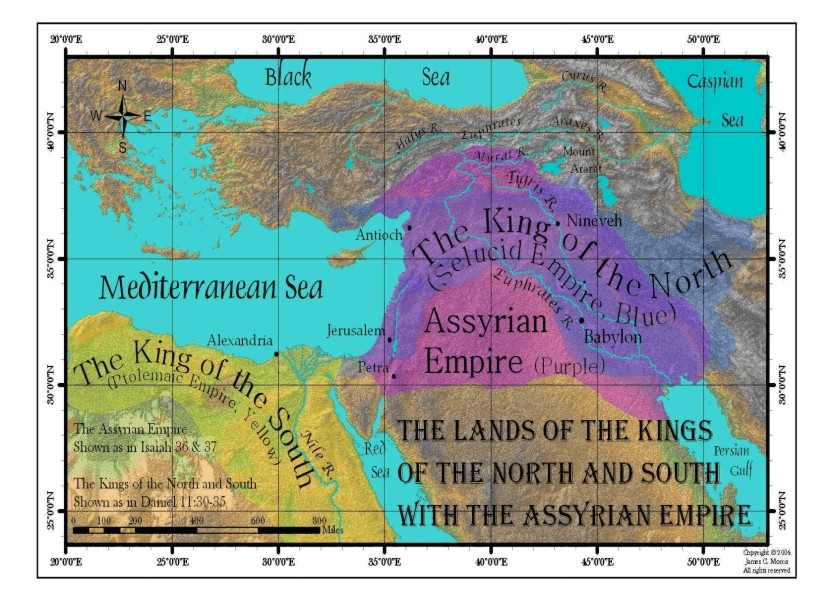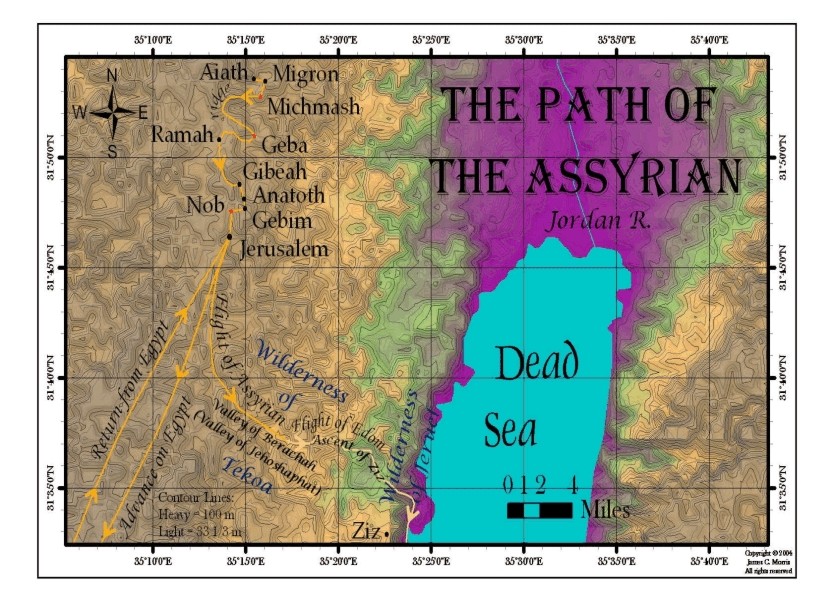Biblewriter posted in message #35:
Modern scholars know about seven different monuments
left by Sennacherib in which he boasted of his
campaigh against Hezekiah. In each of these monuments
Sennecherib listed the cities he had conquered on his
way to Judea. All these cities were along the coast
of the Mediterranian Sea, far from the path described
in this account.
The exact wording of each of these monuments will have
to be provided so it can be seen what they themselves
say.
First of all, if the coastal cities which were
destroyed were only "on the way to" Judaea (if this
is in fact what the monuments themselves say, which
hasn't yet been shown), then those cities could have
been north of a point where Sennacherib turned and
went up into the mountains and down the ridge of
Isaiah 10:28-32.
Or, if the monuments themselves don't actually say
"on the way to" Judaea, they could be a record of
Sennacherib's victories over coastal cities after he
had passed down the ridge of Isaiah 10:28-32 and out
to the coast.
Or, if the monuments themselves do actually say "on
the way to" Judaea, it's possible that after he had
passed down the ridge of Isaiah 10:28-32 and out to
the coast, he destroyed the coastal cities with the
intent of returning back to Jerusalem and defeating
Hezekiah, so that he would have put on the monuments
that the destruction of the coastal cities was "on
the way" to what he planned to be the grand prize of
Jerusalem and the defeat of Hezekiah himself, but
which in fact never happened because God destroyed
his army before he could actually return to Jerusalem
(Isaiah 37:35-37).
Biblewriter posted in message #35:
Finally, 2 Kings 18:17, 2 Chronicles 32:9, and Isaiah
36:2 all say Sennacherib’s forces came to Jerusalem
from Lachish, which was southwest of Jerusalem, not
north of it, as described in this account.
Nothing in 2 Kings 18:17, 2 Chronicles 32:9, or
Isaiah 36:2 requires that Sennacherib hadn't
previously taken the path of Isaiah 10:28-32, but had
only "shaken his fist" at Jerusalem (Isaiah 10:32)
before moving on to try to take other, easier cities
first. Then, while he was laying siege to Lachish, he
could have started to worry how long it could take
him to succeed in a siege against Jerusalem, and so
he sent some people from Lachish to Jerusalem to try
to scare it into surrender with mere words (Isaiah
36:19-20), the same words which had been prophesied
in Isaiah 10:9-10.
Biblewriter posted in message #35:
For all these reasons I maintain that there are few
facts of ancient history as well established as the
fact that the path described in Isaiah 10:28-32 was
not followed by Sennacherib. It is so well established
that the well known historian A. T. Olmstead mocked
how badly Isaiah "blew it" in this prophecy,
commenting that this was simply not the path that
Sennacherib followed. He made this comment in his
monumental 650 page book, "history of Assyria."
The key phrase above is "few facts of ancient
history", as in there are so few detailed facts of
ancient history that no historian can possibly claim
to know all the details of the path which Sennacherib
could have taken in his invasion of Judaea. And the
fact that a historian said Isaiah "blew it" in the
prophecy of Isaiah 10:5-34 shows two things: First,
he agrees that Isaiah 10:5-34 was a prophecy of
Sennacherib's invasion, probably because he could
see how it matches so closely with Isaiah chapters
36-37; but because the historian couldn't find any
surviving detailed facts of ancient history which
supported Isaiah 10:28-32, he for some reason
concluded that Isaiah must have gotten that one part
wrong.
Second, his thinking that scripture can get things
wrong shows that he thinks he knows better than
scripture, which means that he thinks he knows more
than he really knows. So his rejection of Isaiah
10:28-32 could simply be a case of him thinking he
knows something he doesn't really know: that
Sennacherib couldn't possibly have taken that path
down the ridge. The fact remains that Sennacherib
very well could have taken that path. There is no
historical proof whatsoever that he didn't.
If one believes that scripture is inerrant (2 Timothy
3:16), and one will admit that one doesn't know all
the details of ancient history because only a
relatively few have survived, and one will read Isaiah
10:5-34 and Isaiah chapters 36-37 together with an
open mind, without already, for some reason, wanting
Isaiah 10:5-34 to be fulfilled in the future, then one
will see how Isaiah 10:5-34 and Isaiah chapters 36-37
are referring to the same invasion by Sennacherib.
It's the same way with the battle of Gog/Magog. If
one will read Revelation 20:7-9 and Ezekiel chapters
38-39 together with an open mind, without already,
for some reason, wanting Ezekiel chapters 38-39 to be
fulfilled before the time explicitly stated in
Revelation 20:7-9, then one will see how Revelation
20:7-9 and Ezekiel chapters 38-39 are referring to
the same one-time battle of Gog/Magog.
There are so many invasions of Israel in the Bible,
let's not get carried away and start multiplying them
unnecessarily. Let's leave Isaiah 10:5-34 as a past
invasion by Sennacherib, as shown in Isaiah chapters
36-37, and let's leave Ezekiel chapters 38-39 as a
one-time future invasion after the millennium, as
shown in Revelation 20:7-9.
This still leaves an earlier future invasion and
destruction of the current state of Israel in Daniel
11:15-16, which invasion could occur at the start of
the coming tribulation (possibly 2010), and be led by
a huge Iraqi Army which the U.S. will have built up
to invade Iran instead.
And this still leaves subsequent future attacks on
Jerusalem by the Antichrist, such as at the very
start of his being given some power (Daniel 11:21-22),
and then at the abomination of desolation (Daniel
11:21,26) at the beginning of his 42-month world reign
(Revelation 13:5), and then again at the very end of
the tribulation (Daniel 11:41,45), right before the
second coming (Zechariah 14:2-4).
That's certainly enough attacks. No scripture
requires us to invent any more than these. So why
would we want to?







